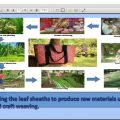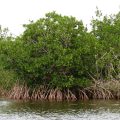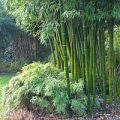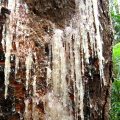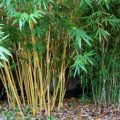The government has awarded 30 enterprising groups that successfully adopted technologies on reforestation while promoting industries and jobs in bamboo, Falcata, talaba (oysters), “tikog,” and “liyang.”
The Ecosystems Research and Development Bureau-Department of Environment and Natural Resources (ERDB-DENR) picked 30 top technology adopters as it celebrates its 30 years with the theme “Teknolohiyang Makakalikasan: Handog ng DENR-ERDB para sa Mamamayan.”
“This is a validation of how ERDB technologies help improve lives of communities while protecting the environment. It is also a showcase of ERDB’s achievements in the last three decades since 1987,” said ERDB Executive Director Dr. Henry A. Adornado.
The technology adopters were selected because of the sustainability of the technology and the benefits derived as reforestation projects contribute to carbon sequestration, biodiversity preservation, and environmental beautification.
Awardees include private individuals, people’s organizations, nongovernment organizations, and local government units (LGU).
These nature conservators were recognized for their accomplishments in planting bamboo; the fast-growing tree Falcata used in making plywood; mangroves that led to selling of talaba, and in propagating the plant specie tikog used in handicrafts-making.
Among the awardees is the town Prosperidad, Agusan del Sur as aided by the PENRO (Provincial Environment & Natural Resources Office) of which has put up 1,357.25 hectares of Falcata plantations in Patin-ay.
It sourced 77 kilos of improved Falcata seeds from the ERDB-run Mindanao Tree Seed Center (MTSC). These were distributed to 472 beneficiaries under the Upland Sustainable Agri-forestry Devt. Program (USAD).
In Bukidnon, for widely distributing the giant bamboo species which are used as support for Mindanao’s export-oriented banana trees, Antonio Dominao was awarded by ERDB.
Dominao was just a government laborer at the experimental and bamboo plantation of ERDB-DENR Region 10. Since 1987, he became interested as an adopter and established a bamboo nursery at his own residence in Impalutao, Impasug-ong, Bukidnon,
Now his nursery sells 50,000 giant bamboo seedlings per month at P20 each, generating P1 million from it.
Dominao was also recognized by the Northern Mindanao Consortium for Agriculture and Resources Research and Development (NOMCARRD) for having been government’s resource person on “Giant Bamboo Production” for seminars for non government organizations (NGOs).
“The improvement of the socio-economic status of Dominao served as an eye opener to the community that inspired them to adopt also the technology (bamboo propagation),” according to ERDB’s Adreana Santos Remo.
Dominao inspired requests for training on bamboo technology and even the demand for the reprinting several times of ERDB’s book “Technology Transfer Volume 10 No.1” on bamboo technology.
A 50-hectare mangrove forestation project of the Balaring Mangrove Planters Assn (BAMPA) was awarded for also promoting talaba culture in Balaring, Silay City, Negros Occidental.
With 35 members organized in 1990, BAMPA has planted mangrove species under a community-based project in 1991 under CARP-ISF (Comprehensive Agrarian Reform Program-Integrated Social Forestry) of DENR-Region 6 (Iloilo City).
It spun off a 4-hectare talaba culture livelihood program from an original one-plot (10mx10M) demonstration. At least 80 families now benefit from it.
Aside from being a shelter belt of the barangay, the mangroves serve as fishpond, generating income for coastal residents.
It even made Brgy. Balaring recognizable for tourists. Brgy. Balaring initiated the “Pagatpat Festival” as the area is also a depository and culture area for more than 10 other shells on top of the oyster.
“Because of talaba culture farms, some residents were motivated to establish talabahan restaurants along the coastal area,” reported ERDB.
For planting and weaving tikog, a plant species scientifically called Fimbristylis globulosa, the Tikog Workers Assn (TWA) from Brgy. Serum, Basey, Samar was recognized.
Organized in 1990 with 30 grassroots residents, TWA members weave tikog leaves into mat and bags with admirable native design.
In 2005, ERDB introduced tikog plantation techniques to ensure a stable source of weaving material as their supply of raw material dwindled.
Tikog technology helped maintain at affordable level price the raw materials. This also promoted sustainable development of a natural and renewable resource. Planting tikog likewise enhanced cultivation of vacant lands—abandoned rice paddies.
“Opportunity for local employment and livelihood is not only limited to mats and handicraft, but it also opened opportunity for farm labor, tikog stalks trading and transport sectors.”
Another awardee from Sto Tomas, Davao del Norte is the San Jose Agroforestry Farmers Assn (SJAFA) which was recognized for creating jobs from bamboo as they make it into the special handicraft “liyang.”
Liyang is a finely woven narrow container made of Bocaue bamboo species used for storage of rice and other food items.
SJAFA members learned bamboo nursery establishment from ERDB. They are mostly vegetable farmers who also traded many goods like latundan and livestock. They practice bamboo propagation through culm cuttings.
They planted bamboo to rehabilitate the Longaob River.
ERDB’s Technology Transfer division collaborated with the Department of Trade and Industry (DTI) Region 11 for skills training on liyang. The technique is also used in bag weaving for women members.
“The members from Sitio Talos are handicraft maker/basket weaver and belong to Indigenous Peoples group of Ata-Manobo tribes,” said ERDB.
Their bamboo finished products have been showcased in many trade fairs and exhibits.
For their bamboo poles, the buyers are TADECO, Marsman, and North Davao Quarry Assn, generating additional income.
“Women earn additional income from ‘liyang’ making priced at P100 to P150 per piece. Women produce 2-3 liyang per day.”
For the bamboo seedling, they sell this at P15 each, P3 goes to the association and P12, to the member that raised the seedling. End (Growth Publishing for ERDB)
PHOTO CAPTION:
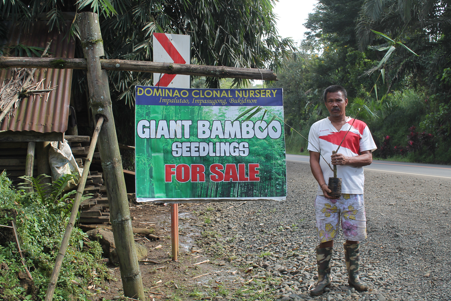
1. Antonio Dominao, former ERDB labourer, now giant bamboo seedling entrepreneur.
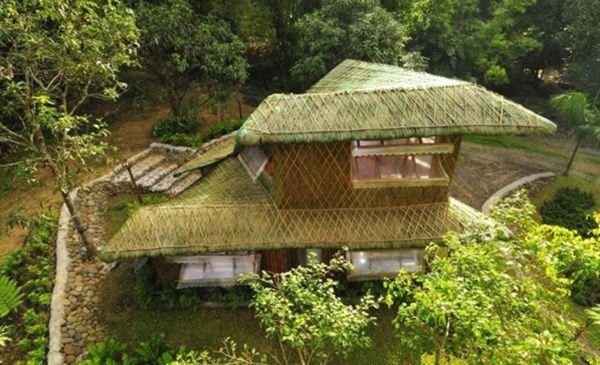
2. Carolina Bamboo Garden

3. Falcata tree: made into plywood, veneer; Credit—pinoyhobbies

4. Falcata tree

5. Giant bamboo

6. Karagomoi as source of livelihood
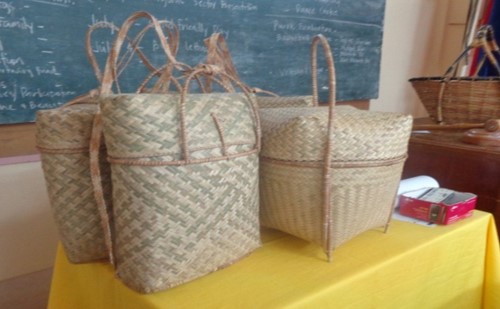
7. Liyang as an income-generating handicraft

8. Mangrove reforestation in Negros Occidental that turned into ecotourism site talaba production center
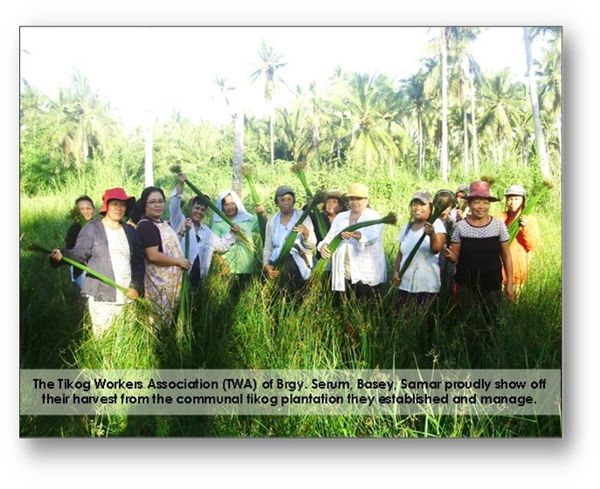
9. Tikog workers show their harvest.
OTHER AWARDEES
1. Diwata Farm is a co-operator of progeny trial establishment and government’s Industrial Tree Plantation (ITP) Production and Technology transfer. It developed a total of 60 hectares of Falcata farms from Mindanao Tree Seed Center (MTSC).
2. The LGU in Tagbina established a 2-hectare seedling seed orchard for Falcata in Dona Carmen, Tagbina, Surigao Del Sur. DENR’s DAO 99-13 has named Caraga Region a Forest Plantation Corridor even as a majority of 60-70% of the country’s wood production comes from Caraga (Agusan, Surigao provinces, Butuan).
This industry helps a lot of small tree farms as 96.94% of total area of plantations in Caraga are held by small farmers. Falcata yield there has been at a low of 77.3 cu.m. per hectare due to poor physiological quality of seeds and poor plantation management.
Through ERDB’s technology on selection of seed, planting stock production, they are able to raise productivity.
Forest farmers attend ERDB’s training on seed tree technologies, nursery and plantation development, plantation management and protection, and Industrial Tree Plantation.
3. The Casinillo Nursery in Brgy. Fili, Bayugan, Agusan del Sur sourced 1.5 kilos of Falcata seeds from MTSC. It has been successful in tree planting since the Caraga Farmers and Environmental Developers Multipurpose Cooperative (CFED-MPC) members attended ERDB’s trainings on nursery development. CFED-MPC has become a cooperator in the Industrial Tree Plantation (ITP) technology transfer project in Caraga. CFED now disseminates its own book “How to Grow Falcata.”
4. The Carolina Bamboo Garden (CBG) by Kay G. Jimenez in San Jose, Antipolo City, Rizal was put up in 1998. ERDB installed here a gene bank as conservation area for various bamboo species here. The CBG, a project with Majent Foundation Inc., was originally conceived as a center for bamboo information in Metro Manila.
5. Another product is the pagatpat that earned the award for the Pangapog Assn Inc. (PAI) of Brgy Tambo, Island Garden City of Samal, Davao del Norte. The project started as ERDB Region 11 extended to the PAI aid in rehabilitating Sanipaan Shoal.
ERDB Staff Abdulrahman C. Damada taught the residents on pagatpat seedling production. He used a recovery chamber technology to produce pagatpat wildings.
A 3-hectare area in Sanipaan Shoal was planted with pagatpat wildings raised in the recovery chamber. From raising pagatpat seedlings, each family earns on the average P3,000 to P5,000 a month.
When picked up at the nursery, pagatpat seedling is sold at P20, and an additional P15 is added if the seedling is delivered to Sanipaan shoal by boat
With the effort to grow pagatpat, Sanipaan shoal “vanishing island” is now an ecotourism learning destination. Women there raise an average of 200 potted pagatpat seedlings per day. Private firms – the Rotary Club of Davao and academic institutions — also helped rehabilitate Sanipaan by adopting an area for them to plant mangrove.
6. The Kawayan Farm by CS First Green AGri Indl Devt Inc. was put up in 1980 as a reforestation project and for soil erosion prevention. It produces bamboo supplies for furniture and fishpens.
7. Another bamboo project is the clonal nursery in Camp 7 Non-Timber Planters (CNTP) MPC in Minglanilla, Cebu. With 29 members within the Osmena Reforestation Project, the Philippines’ oldest reforestation project, the CNTP MPC is a partner in conserving the remaining natural stand within the experimental forest.
Its people trained on bamboo seedling production, clonal nursery management, and ecotourism. The clonal nursery uses vegetative propagated rootstocks in forest tree nurseries which is a cheap reproduction method for clonal stocks. It also guides visitors and caters food to them as part of ecotourism. As it manages a recycled waste display center, it sells souvenir items from recyclable materials to tourists.
8. In Iloilo, an awardee in bamboo planting is the Katilingban sang Pumuluyo nga naga Atipan sa Watershed sang Maasin (KAPAWA-MAASIN). It has 1,584 members and was a science & technology model farm on bamboo and woven products.
Bamboo rehabilitation is done through site and stand identification, cleaning of clumps and unwanted generation, and pruning of old bamboo clumps in order to decongest planting areas.
ERDB’s intervention is in helping produce good quality poles — straight, with bigger diameter, doubled number of shoot emergence compared to unmanaged clumps, and well-distributed culms in the clump.
“Bamboo produces more biomass when managed intensively; hence more carbon will be sequestered.”
9. Also in Iloilo, another awardee is the municipality of Maasin as its leader, Mayor Mariano Malones, believed in bamboo’s potential as a world class non-timber forest product.
Maasin is now known as Iloilo’s bamboo capital as it makes numerous products from bamboo — barbecue sticks, toothpick, charcoal. Also known for its bamboo festival called “Tultugan,” Maasin has a “green belt” area through its riparian areas (riverbanks) which are planted to bamboos that protect the town especially during strong typhoons.
Maasin’s “Kawayan Kabuhi Sang Tanan” is a nursery program that grows bamboo seedlings.
10. For charcoal briquetting, ERDB awarded the Kalibo Save the Mangrove Assn (Kasama) of New Buswang, Kalibo, Aklan.
With 197 members, it maintains the New Buswang Mangrove Ecopark in Kalibo. It produces charcoal briquette which has superior heating capacity and has longer useful life. Kasama’s profit from charcoal briquettes goes to more jobs creation in the Allen Salas Quimpo Bakhawan Eco-Park.
“Charcoal briquetting becomes a source of pride as the only approved charcoal supplier in Aklan using sustainable and environmentally friendly methods,” said ERDB.
Charcoal briquettes improve cost efficiency in the operation of local restaurants due to cheaper and more sustainable source of cooking fuel. It is even environmentally sustainable with the efficient use of biomass.
Kasama tapped coastal families to produce and market green charcoal to alleviate poverty, promote respect for good environment and serve as a model for rural development.
11. The SEAMANCOR Ecodevelopers Assn Inc. led by Joselito Domdom implemented the Coastal Environment Program in Prieto Diaz, Sorsogon. This gave way to community-based enterprises that accomplished many family goals like successfully sending children to school through the production of shrimp and crabs.
“The right mix of political will, scientific know-how, and people’s support sustain Prieto Diaz today,” said ERDB.
12. Another awardee in bamboo is the Municipal Environment and Natural Resources Office (Soledad T. Prena) of Ligao City which has established a Bambusetum and kawayan tinik plantation.
“Community participation results in wider technology adoption,” said ERDB on the success of Ligao City.
13. The FGAID in Sitio mapita, Laoag, Aguilar, Pangasinan was put up in 2014 for income generation for rural folks.
14. Another awardee, the Tuboran Elementary School (TES) in Mawab, Compostela Valley employed the use of coconut coir in combination with materials from Falcata, mahogany, narra, and African tulip.
TES interplanted these tree species with forage peanut as they learned rehabilitation technologies for severely eroded area from ERDB.
“Surface run-off gadgets were installed in the area to assess the combination of coco coir and vegetative measures. Run-off plots and catchment approach was used to measure the erosion rate.”
Because of this effort, the town was able to save a P5 million worth building from losses from calamities that could have given away to landslide. This is why the town has supported replication of the technology in other landslide prone areas in Tuboran, Mawab, Davao del Norte.
15. For rattan, an awardee is the Evergreen Tree Planters Assn of Tandang Sora (ETPATS) in Gov Generoso, Davao Oriental.
The ETPATS is a CARP-ISF beneficiary. ERDB has tied up with DTI to assist it on trainings on product development of 200 rattan gatherers. They are now into 27 years in the rattan industry. As they established an additional 5-hectare rattan plantation on top of their existing 25 hectares, they have stabilized supply of raw material for furniture and basket production.
They also maximized land use through planting of Almaciga tree as host plant for their rattan plantation. Following after the model of Davao Bohol Trading, Resort Owners, and Fish Traders, they also put up a market for their baskets and hammock “duyan.”
They earn a net income of P46,650 at the production rate of 50,000 palasan seedlings.
16. In Gov Generoso, Davao Oriental, the town was also awarded for their almaciga plantation and resin tapping technology. Through the Biodiversity Partnerships Project, ERDB extended training on inventory of almaciga trees to the municipality. ERDB taught locals sustainable methods of tapping Almaciga trees for resin production.
ERDB helped institutionalize tappers’ certification, proper permitting, consolidation, inspection, management, trading and forest protection for the project of the Lumad Almaciga Tappers Association of Governor Generoso (LATAGG).
“There was a significant increase in almaciga resin production yield with zero-minimal damage incurred on the tree. There was an increased participation of local communities in sustainable almaciga tapping. Increased income of almaciga tappers was P1,500 – 2,000 weekly,” reported ERDB.
The residents also serve as forest guards. This is why timber poaching was minimized; almaciga trees and other forest tree species have been preserved. Very important, this project enhanced biodiversity conservation in the unprotected region of Mt. Apo, a key biodiversity area.
17. For the clonal propagation of Hi-QVAM 1 Technology, ERDB awarded the Taganito HPAL Nickel Corp. that put up a plant clonal propagation facility and the THPAL Nursery.
18. For anahaw production, awardee is the Lesnianas of Pinagbobong, Tabaco, Albay. Through anahaw, the Lesnianas were able to send all eight children to school. They also used raffias (young leaves) for making fans and decorative items.
Mature anahaw leaves when bundled also have applications in making roofing materials for huts and houses.
19. Another awardee is the Manaet Tanagan Farmers Assn Inc. They have adopted ERDB’s technology on leaf production and processing of karagomoi, scientifically called Pandanus simplex which is used for weaving mats and handicrafts.
Karagomoi products are the source of livelihood of island barangays in Bacacay, Albay. But since the town is visited now and then by strong typhoons and winds, their livelihood from Karagomoi has been adversely affected.
Using ERDB’s prescribed planting distance, a 25-hectare plantation was put up for Karagomoi in Brgys. Manet and Tanagan in Bacacay. Intercropping was made—Karagomoi and anahaw; Karagomoi and tigergrass; and Karagomoi and crops.
ERDB taught them techniques on seed collection and planting and maintenance, harvesting, leaf processing, drying, and flattening, weaving into products, product marketing of the mat and handicrafts. (Growth Publishing for ERDB)
For any questions or interview requests, please contact 0929-715-8669, 0917-102-6734
